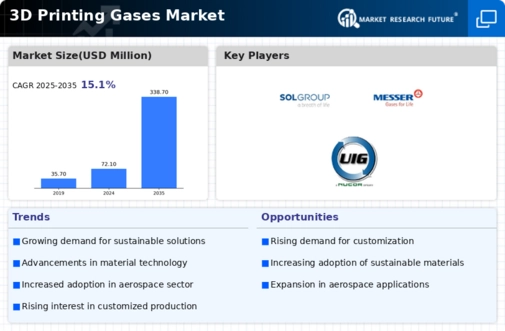Top Industry Leaders in the 3D Printing Gases Market
 Beyond the whirring of printers and the molten glow of filament, a hidden world of gases fuels the revolution of 3D printing. the unsung heroes, influencing the quality, efficiency, and even aesthetics of printed objects. However, beneath the seemingly simple surface of this market lies a fierce competition, where established giants and innovative startups vie for dominance with diverse strategies and evolving trends. Let's delve into the factors shaping market share, industry news, and recent developments that paint a vibrant picture of this dynamic landscape.
Beyond the whirring of printers and the molten glow of filament, a hidden world of gases fuels the revolution of 3D printing. the unsung heroes, influencing the quality, efficiency, and even aesthetics of printed objects. However, beneath the seemingly simple surface of this market lies a fierce competition, where established giants and innovative startups vie for dominance with diverse strategies and evolving trends. Let's delve into the factors shaping market share, industry news, and recent developments that paint a vibrant picture of this dynamic landscape.
Key Players and Adopted Strategies:
-
BASF (Germany): This chemical giant leverages its global reach, extensive production capacity, and brand recognition to secure a significant market share. Their focus on high-purity gases like argon and helium, coupled with technical expertise, attracts premium customers in demanding industries. -
The Linde Group (Germany): Another diversified gas giant, The Linde Group capitalizes on its global distribution network and innovative gas delivery solutions. Their focus on customized gas blends and on-site support caters to the specific needs of various 3D printing technologies and applications. -
Air Liquide S.A. (France): This French multinational leverages its strong presence in Europe and its expertise in medical gases to cater to the growing demand for 3D printing in healthcare. Their focus on biocompatible gas mixtures and regulatory compliance strengthens their position in this critical sector. -
Praxair Inc. (USA): A leading industrial gas supplier, Praxair Inc. focuses on cost optimization and bulk production to offer competitive pricing. Their focus on volume deals and partnerships with regional distributors caters to price-sensitive markets. -
Air Products and Chemicals Inc. (USA): This diversified chemicals and gas company emphasizes innovation and sustainability. Their focus on developing new gas mixtures for specific 3D printing applications and exploring bio-based alternatives resonates with environmentally conscious customers.
Factors Shaping Market Share:
-
Technological Advancements: The adoption of new 3D printing technologies like metal printing and multi-material printing creates demand for specialized gas mixtures and delivery systems. -
Regional Growth: Expanding into high-growth regions like Asia and Latin America unlocks new customer segments and market potential. -
Cost Optimization: Efficient gas delivery systems, minimizing gas waste, and offering competitive pricing are crucial for profitability in price-sensitive markets. -
Downstream Applications: Growth in key industries like aerospace, automotive, and healthcare drives the demand for specific 3D printing gases. -
Sustainability: The rising demand for eco-friendly solutions pushes manufacturers towards bio-based gas sources and responsible production practices.
Key Companies in the 3D Printing Gases Market includes
-
BASF SE (Germany)
- Linde PLC (Ireland)
- Air Liquide (France)
- Air Products and Chemicals, INC. (US)
- Nippon Sanso Holdings Corporation (Japan)
- SOL Group (Italy)
- Messer Group (Germany)
- Universal Industrial Gases (US)
Recent Developments:
-
June 2023: Praxair Inc. expands its distribution network in China, aiming to capitalize on the booming Asian 3D printing market. -
August 2023: Air Products and Chemicals Inc. introduces a novel gas mixture specifically designed for multi-material 3D printing, enabling the creation of complex and functional objects. -
October 2023: A startup unveils a new portable gas delivery system for 3D printers, offering greater flexibility and accessibility for users. -
November 2023: BASF invests in research into using 3D printing gases for energy harvesting applications, paving the way for innovative energy solutions. -
December 2023: The Linde Group and Air Liquide S.A. partner with leading research institutions to develop next-generation gas sensor technology for 3D printing, optimizing gas usage and improving print quality.

